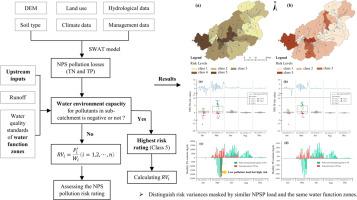Water Research ( IF 12.8 ) Pub Date : 2023-05-17 , DOI: 10.1016/j.watres.2023.120092 Yuanyuan Li 1 , Hua Wang 1 , Yanqing Deng 2 , Dongfang Liang 3 , Yiping Li 1 , Qihui Gu 4

|
Comprehension of the spatial and temporal characteristics of non-point source (NPS) pollution risk in watersheds is essential for NPS pollution research and scientific management. Although the concept of water functional zones (WFZ) has been considered in the NPS pollution risk assessment process. However, no comprehensive study of the NPS pollution risk has been conducted to effectively protect water quality in watersheds with different water environment capacity. Therefore, this study proposes a new NPS pollution risk assessment method that integrates water functional zoning, receiving water body environmental capacity, and space-time distribution of pollution load for quantifying the impact of pollution discharge from sub-catchment on nearby water body quality. Based on the NPS nutrient loss process modeled by the Soil and Water Assessment Tool (SWAT), this method was used to assess the NPS pollution risk in the Le 'an River Watershed at annual and monthly scales. The results showed that the NPS pollution risk is characterized by seasonal and spatial variability and is influenced clearly by the water environment capacity. High NPS pollution loads are not necessarily high pollution risks. Conversely, a low NPS nutrient pollution load does not represent a low regional risk sensitivity. In addition, NPS risk assessment based on the water environment capacity could also distinguish the differences in risk levels that were masked by similar NPS pollutant loss and the same water function zoning to achieve accurate control of NPS pollution management in watersheds.
中文翻译:

应用水环境容量评估流域面源污染风险
了解流域非点源 (NPS) 污染风险的时空特征对于 NPS 污染研究和科学管理至关重要。尽管在 NPS 污染风险评估过程中已经考虑了水功能区 (WFZ) 的概念。然而,目前还没有对NPS污染风险进行全面研究,以有效保护不同水环境容量流域的水质。因此,本研究提出了一种新的NPS污染风险评价方法,该方法将水功能区划、接收水体环境容量和污染负荷时空分布相结合,量化子流域污染排放对附近水体质量的影响。基于水土评估工具(SWAT)模拟的NPS养分流失过程,该方法用于评估乐安河流域NPS污染风险的年度和月度尺度。结果表明,NPS污染风险具有季节性和空间变异性特征,受水环境容量影响明显。高 NPS 污染负荷不一定是高污染风险。相反,低 NPS 养分污染负荷并不代表低区域风险敏感性。此外,基于水环境容量的NPS风险评估还可以区分类似NPS污染物损失和相同水功能区划所掩盖的风险水平差异,实现流域NPS污染管理的精准控制。该方法被用于评估乐安河流域年和月尺度的NPS污染风险。结果表明,NPS污染风险具有季节性和空间变异性特征,受水环境容量影响明显。高 NPS 污染负荷不一定是高污染风险。相反,低 NPS 养分污染负荷并不代表低区域风险敏感性。此外,基于水环境容量的NPS风险评估还可以区分类似NPS污染物损失和相同水功能区划所掩盖的风险水平差异,实现流域NPS污染管理的精准控制。该方法被用于评估乐安河流域年和月尺度的NPS污染风险。结果表明,NPS污染风险具有季节性和空间变异性特征,受水环境容量影响明显。高 NPS 污染负荷不一定是高污染风险。相反,低 NPS 养分污染负荷并不代表低区域风险敏感性。此外,基于水环境容量的NPS风险评估还可以区分类似NPS污染物损失和相同水功能区划所掩盖的风险水平差异,实现流域NPS污染管理的精准控制。结果表明,NPS污染风险具有季节性和空间变异性特征,受水环境容量影响明显。高 NPS 污染负荷不一定是高污染风险。相反,低 NPS 养分污染负荷并不代表低区域风险敏感性。此外,基于水环境容量的NPS风险评估还可以区分类似NPS污染物损失和相同水功能区划所掩盖的风险水平差异,实现流域NPS污染管理的精准控制。结果表明,NPS污染风险具有季节性和空间变异性特征,受水环境容量影响明显。高 NPS 污染负荷不一定是高污染风险。相反,低 NPS 养分污染负荷并不代表低区域风险敏感性。此外,基于水环境容量的NPS风险评估还可以区分类似NPS污染物损失和相同水功能区划所掩盖的风险水平差异,实现流域NPS污染管理的精准控制。NPS 养分污染负荷低并不代表区域风险敏感性低。此外,基于水环境容量的NPS风险评估还可以区分类似NPS污染物损失和相同水功能区划所掩盖的风险水平差异,实现流域NPS污染管理的精准控制。NPS 养分污染负荷低并不代表区域风险敏感性低。此外,基于水环境容量的NPS风险评估还可以区分类似NPS污染物损失和相同水功能区划所掩盖的风险水平差异,实现流域NPS污染管理的精准控制。


























 京公网安备 11010802027423号
京公网安备 11010802027423号